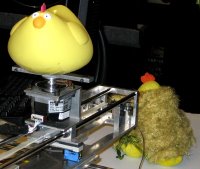
Live from CHI 2006 – Thursday, April 27
9:00
A presentation by David Adhlstroem on an experiment that aims at reducing the selection time of multi-level dropdown menus. He uses the law of Fitts to explain how slow and difficult selection is because of the left to right movement required to reach the dropdown sub-menus.
This study was administered to two test groups, one that used the mouse to navigate the dropdown menus and one that used the touchpad. Instead of the classic mouse hover, clicking on a menu item allowed the user to go directly to the next sub-menu. This improved selection speed by 5% to 20%, depending on the case.
10:00
The author Yelena Nakhimovsky describes how she adapted the card sorting methodology to reorganize the information architecture found in the help section of Google’s AdWords. This section contained more than 500 items and her goal was to reduce it by half.
 The reorganization of the information architecture was done in four stages: the first was a qualitative analysis, followed by two card sorting tests “adapted” for the needs of the experiment (the current methods and software were too limiting) and, finally, a comparative study of the old and new architectures.
The reorganization of the information architecture was done in four stages: the first was a qualitative analysis, followed by two card sorting tests “adapted” for the needs of the experiment (the current methods and software were too limiting) and, finally, a comparative study of the old and new architectures.
Results: the number of items was cut in half and there was a 30% improvement in the selection speed of the new information architecture. According to the author, this method could be used to organize a large volume of information.
11:30
Presentation of many accessibility studies. Melissa Dawe presented a touching case study describing the implementation of assisted technologies for youth and young adults with intellectual deficiencies and their families. The abandonment rate of these technologies is more than 35%, even though they can have a major impact on the well-being of these users and their families.
This study demonstrated the importance of analyzing and understanding the different roles of each player in the implementation of these technologies: the teacher, the parents, and the young adults.
Generally, according to the author, studies that aim to develop new assisted technologies rarely consider the user context, environment, perception and efficiency of the current technologies being used in the home or at school.
This presentation concluded with an outline of the hopes and dreams of the young adults and their families who were interviewed. They wish for technologies that can support and stimulate them, that are easy to use and to reconfigure, that are crash-resistant; technologies that provide a lifeline.
 1:00
1:00
Thumbs up to Pierre-Alexandre who conducted an orchestra with his infra-red baton, and to the chickens who responded to being stroked 😉
0 Comment(s)